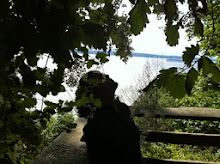“Jack can see he sees
what he can see Jill can’t see
and he can see
that Jill can’t see that she
can’t see
but he can’t see why
Jill can’t see that Jill can’t
see.”
– R. D. Laing, ‘Knots’
‘Who are you going to
believe, me or your eyes?’
– Grucho Marx, ‘Duck Soup’
It is spring. I am considering the Bigleaf Magnolia, quietly and as
unobtrusively as I can. Or so I think. Yet, my being still and looking at a
flower has caused an unintended ripple. For this is a much visited tourist
spot. Many determined people solemnly, briskly walk the highline, only stopping
to take photographs. As expected a few stop next to me, click a quick picture
and move on, others shrug their shoulders (probably thinking ‘what’s she looking
at’) and the more mindful people (concentrating on one thing at a time) quickly
estimate a way to bypass me without slacking their pace.
An elderly woman asks, ‘what flower is that?’ I reply, ‘Magnolia, a
bigleaf magnolia.’ She, ‘It looks nothing like the magnolia in my garden’ and
shaking her head walks away.
(Bigleaf Magnolia has the largest simple leaf and single flower among
all native North American plants.)
 |
| A season of birds in NYC. Some prominent ones missing because there was no camera on hand. |
“Every person takes the
limits of their own field of vision for the limits of the world.”
–Arthur Schopenhauer,
‘Psychological Observation (Studies in Pessimism)
It is summer. In Chelsea, a robin is singing (Cheer up; cheer-ee-o).
The song can be discerned among the human noises, only if you listen very hard.
Yesterday at lunch someone said that the only birds you see in New York
are pigeons. Perhaps she belonged to that category of Americans who according
to a Cornell Lab poll thought that house sparrows grew up to become pigeons.
Meanwhile on this summer day, by listening very hard I heard more than
a handful of birds call out to the morning. And all before lunchtime. (The
birds were: White-throated Sparrow, Northern Cardinal, American Robin, House
Sparrow, Starling and Northern Mockingbird.)
“Seeing is a neglected
enterprise.”
–Saul Leiter (quote from his
obituary in New York Times)
“The hardest thing to see is
what is in front of your eyes.”
– Goethe
It is autumn. We are walking on 20 some street, right next to the
public housing projects (that is low-cost housing for the working classes–
nurses, policemen, teachers and such like) when she suddenly blurts out, “You
don’t see any black people in New York, how surprising.” I
am speechless for a split second. To start some of our neighbors are “black people”, the four
concierges in our building are “black people” and right now we are walking besides
towers that house mostly “people of color”. How blinkered has our vision become?
What is the function of the human eye?
But then most people from India who visit us in New York are people of
a certain educational and class background, who like people of their kind all
around the globe throw around their biases and ignorance as unselfconsciously
and as loudly as their voices (especially in public places)– they are
unapologetic about flaunting their privilege because for the most part they
have chosen to be willfully ignorant.
And no, just because you’ve watched Friends, it doesn’t mean you
‘know’ life in New York City.
“Let every eye negotiate for
itself,
And trust no agent”
– William Shakespeare, ‘Much Ado About Nothing’
“One hundred tellings are
not as good as one seeing.”
–Chinese proverb
It is winter, a freakishly warm winter. I am contemplating the parable
about a student in search of a renowned teacher. Every culture has some version
of the story. A student seeks a great teacher. But to get to the sought after
teacher, the student has to go through certain hardships– ford unruly rivers
and climb steep mountains, or else, solve tricky puzzles– to prove to be worthy
of the wisdom being desired. Often wisdom is found during the course of the
search itself, even before the student sets sight on the teacher. Because
knowledge though arguable free, does not come to
those who wait passively.
And sometimes, even the best of teachers can’t help you. For as the
German proverb goes, if the eye does not want to see it, neither light nor
glasses will help.
And then there are those other times:
“(What do you see when you
turn out the light?) I can’t tell you, but I know it is mine.”
– Lennon–McCartney, ‘With a Little Help from My Friends’









































